How To Edit White Product On White Background
The clandestine to an online store'southward success is making an excellent commencement impression, and nothing does that better than practiced-quality production photography.
When it comes to creating product listings for your online shop, white background production photography can make a massive difference to your conversion rates.
- Co-ordinate to Shopify , "50% of online shoppers think that product photos are more important than product data, reviews, and ratings."
And information technology doesn't take an adept to effigy out why: when shopping online, product photos are the simply way a buyer gets a sense of what you're selling. Product photography is vital to both on- and off-site marketing, every bit photos play a crucial role in your shoppers' buying-decision process.
Not only are your product photos viewed on your site but too in your PPC channels, such as Google Ads for eCommerce , Facebook ads , Microsoft ads, and your social production ads and posts, including YouTube ads and other video marketing thumbnails.
Here's what we will encompass in this guide; feel costless to jump ahead!
Merely first, permit's talk nearly types of photography.
Best Types of Product Photography
In that location are 2 main types of production photography:
- In-context (or lifestyle photography)
- Product-only images
Here'south an instance of each from one of our favorite merchants, Quondam Guys Rule .
Lifestyle product photos are product photos that prove your products being used. Here are some examples of their lifestyle shots, the same types of photos you may use in your Instagram marketing.
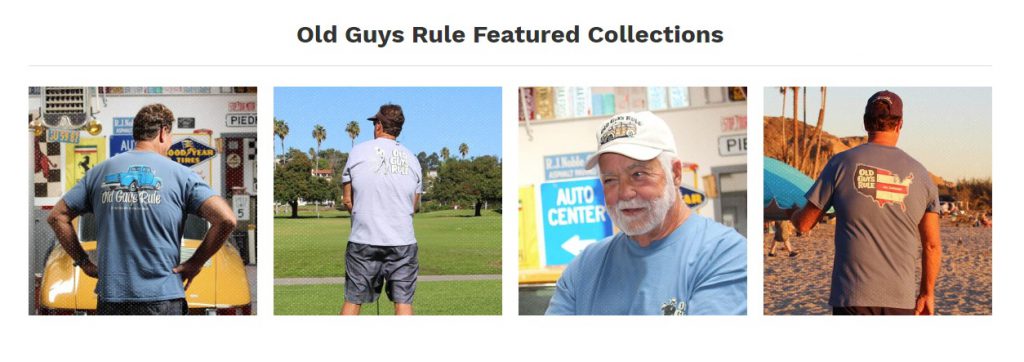
Production-only photos are clean, white background photography photos of your production, every bit seen below.

Today nosotros will be discussing product-only photos.
Nosotros will become through why white background product photography is cardinal to upping your product photography game, and guide you through shooting and editing your own product photos like a pro.
So grab that coffee and get set for your complete guide to creating product photos for ads and your store!

Why Use White Background Product Photography?
ane. They Make Your Products Pop
The benefit of choosing i background color is store consistency, and white offers the most continuity and makes dissimilar color and style products look great. Plus, if y'all want to evidence your products with the fewest distractions, white backgrounds are the best way to do this.
two. They Offering More Versatility for All Marketing Channels
If y'all're on a tight budget, you want to ensure that the product photos you shoot can exist used in your marketing and eCommerce ads as well.
For example, with Google Shopping campaigns , your production photos can simply have white, gray, or lightly colored backgrounds.
Pro Tip: Don't forget to review and tweak your Product feeds before meridian shopping days – including product images! This volition assistance you boost sales during high search volume days. You can read more about optimizing your vacation campaigns here: Holiday Shopping Google PPC Strategy for eCommerce Retailers. Also exist sure to use automation tools to run and optimize these campaigns on autopilot.
Or, if you decide to become a multi-channel seller and include Amazon as a market place, one of their image requirements is that backgrounds be pure white (RGB 255, 255, 255).
3. White Background Photos Are Easier to Edit
When it comes to shooting and editing your product photos yourself, white backgrounds tend to make it a lot easier for beginners to create awesome product photos.
4. It's Easier to Upgrade from White Production Photos to Color
When you think production photography white groundwork, you lot think boring.
Merely the truth is, even if you want to add a spot of color to your product photo by making your background neon yellowish, you lot need to start with a good groundwork that'due south like shooting fish in a barrel to edit.
The easiest color to work with in terms of production paradigm editing and background removal is white.
—
At present that nosotros know why product photography on white backgrounds is the all-time selection for eCommerce product-but images, permit's get into creating photo guidelines, product photography must-have equipment, and how to shoot and edit your ain product photos.
How to Create a Product Photography Guideline and Why You Demand One
Before you go camera-happy, you lot need to come up with an action plan. In product photography terms, this is your photography guideline.
Why exercise we do this first?
Because the aim is to create a consistent look and feel for your eCommerce brand.
This volition non only aid with building a potent brand presence, simply ensure you lot exude quality.
This guideline is dynamic, and you'll work on it while you lot're shooting your first photos, until yous've finished editing them to your standard. The most important things to rail and include in your guidelines are:
- Editing software and setting
- Lighting setup, product angles, and distances betwixt your digital camera and your product
- Full general image saturation
- Overall colour palettes
- Focal length
- Epitome dimension and size
- Ratio of white space around each product
Creating a guideline to follow will help ensure that all the photos you take will take a consistent experience and maintain a like size and scale. It volition besides salve you a lot of time as your number of new products increases.

What Basic Production Photography Equipment Should Yous Utilize?
The must-have tools for product photography on a white background are as follows:
1. White Groundwork
Firstly, if you are non using a lightbox (see below), you volition need to create a plain white groundwork. This can exist a white wall, poster board, or total backdrop.
For an absolute newbie on a upkeep, you lot can commencement with a white poster board – but make sure it's non off-white or foam. If you're using a white wall, make sure information technology'south smoothen and without textures that will exist impossible to edit out.
If y'all're looking to invest in product photographs for your eCommerce store, whatsoever photoshop or marketplace like Amazon has a variety of white background options – with the well-nigh versatile existence sweep patently white backgrounds that yous can roll.
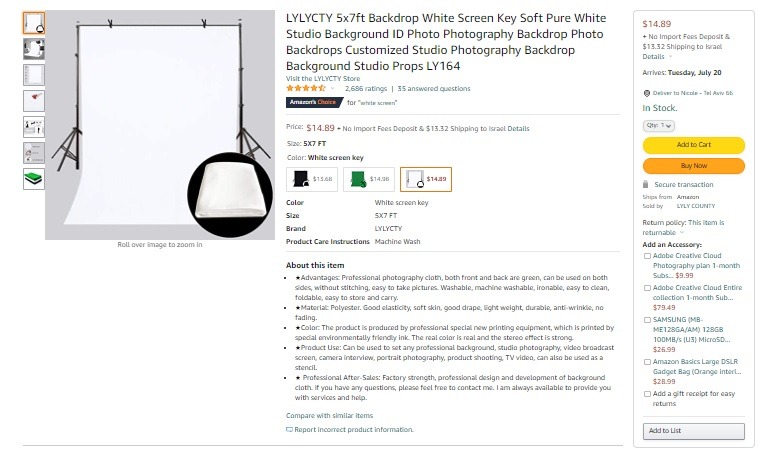
two. Lite Box or Low-cal Tent
Low-cal boxes are see-through boxes that permit concentrated low-cal through only soften whatsoever direct light. The advantage of this is it provides consequent lighting settings while eliminating the chance of likewise many shadows.
You tin either go lightboxes that come with built-in lights, or if you have a bigger budget, you can get a softbox and add your own lighting (which is what we recommend).
The advantage of the latter is that most fix-made LED calorie-free boxes tend to be on the small side, which is limiting. They also give you much less command over your lighting.
Here are some of the nearly popular lightbox brands:
- LimoStudio
- FotodioX LED Studio-in-a-Box
- Neewer
- Square Perfect
- Polaroid Pro Table Top
Alternatively, if you're feeling crafty, you can make your own lite box! Here's how to build a great DIY lightbox for under $l:
3. Shooting Table
This tin can be a table, chair, stool, or any completely flat surface in your home that y'all can shoot on. If you lot are using natural light, ensure that you will be able to place your shooting table or stand virtually a window (lite source).
4. Lights & Bulbs
Next, you will need clamp lights and bulbs. If you're not using natural calorie-free (which we will discuss later), they will be your main calorie-free source, and you will need three of them. We recommend 100-watt daylight bulbs for your clamp lights.
v. Tripod
You lot can shoot without a tripod, but if you want to brand certain that y'all are keeping your photos consistent in terms of distance, lighting, and angles, we recommend investing in 1. A proficient production photography tripod will accept the following:
- Built-in spirit-level
- Orientation adjustability
- Height adjustability
- Stability
- Payload (your tripod can carry the weight of your camera and heaviest lens)
Some pro tripods include the Gitzo GT2541EX Series 2 and the Manfrotto 058B Triaut Camera Tripod .
vi. Digital Camera or Smartphone
1 of the most of import pieces of equipment is your camera. If yous have a smartphone with a swell photographic camera, in that location is no need to invest in a DSLR merely yet. Here are some smartphones which take specs good enough to shoot with:
- Google Pixel & Pixel XL
- Apple iPhone 8 or college
- Samsung Galaxy S8 or higher
- LG G6 or higher
In the long run, buying a DSLR is a good product photography investment.
vii. Photo Editing Software
Lastly, you will need photo editing software to make those important photograph tweaks after your shoot. There are enough of free and paid photo editing software and online platforms out at that place. Choosing between them should be based on your budget, your comfort, your PC/Mac specs, and your photo needs. Some leading editing software and platforms include:
- Online platform Pixlr (free and pro version)
- Photoshop
- Lightroom
- GIMP
How to Shoot Products on a White Background
To DIY your white groundwork photos, you should follow these 6 cardinal steps.
- Pick your lighting
- Set up your background
- Place your products
- Gear up upwardly your tripod
- Apply the right digital photographic camera settings
- Shoot your product photos the right way
Let's swoop deeper into each.
Stride #1: Pick Your Lighting
The offset and virtually of import step is to pick your lighting. Getting your light right from the start means less time and effort at the editing phase. You have ii light options when shooting your product photos: natural light or studio light.
1. Natural Light
Natural light is a good option if you have a smaller budget and aren't using a lightbox.
In fact, at that place are enough of professional photographers who prefer natural light over studio lighting where possible. Just it does accept some work and comes with a little more of a learning curve.
You will want to brand sure that you have enough lite but are not shooting in straight sunlight, every bit this will create shadows, which you don't want.
The best manner to shoot with natural light is by placing your shooting table near a big window that brings a lot of (indirect) low-cal into a room. You lot tin use white cloth or paper to embrace the window to filter and soften the light. You as well want to make sure you're shooting at the brightest fourth dimension of day.
two. Studio Lights
If you have a little more budget for your product photography, it is worth investing in practiced lighting and a soft lightbox, which we mentioned in the photography equipment section. With your soft lightbox, you volition demand 2 or three prune-on or clench lights with strong bulbs.
Y'all need a minimum of one low-cal to act equally your make full light (backlight) and one equally your fundamental light, which is placed in the front and to the side of your box. You will and then need to play around with your low-cal angles and distances until you have an even distribution of light and shadows.
Here's a quick video guide on where to set upward your clamp lights when using a lightbox or tent.
If you do opt for a lightbox with congenital-in light, here's a guide to setting up your lights from the guys behind Foldio2 and Foldio3 – a popular light box product.
No matter what lighting solution you selection, you are aiming to ensure the top, sides, and production are all well-lit, and either all have the aforementioned shadow tone that you lot burnish up afterwards, or accept no shadow at all. The primal here is light consistency throughout.
Pace #2: Set up Your Production Photography Background
Whether you're using natural light and a white properties, a lightbox, or a tent, you should ensure that your groundwork material or backdrop is set up with a sweep.
This ensures you lot have no sharp corners or blemishes behind your production.
In other words, you desire to ensure that information technology doesn't sit at a 90-degree angle to the chair, box, or table, but is at a curve like this:
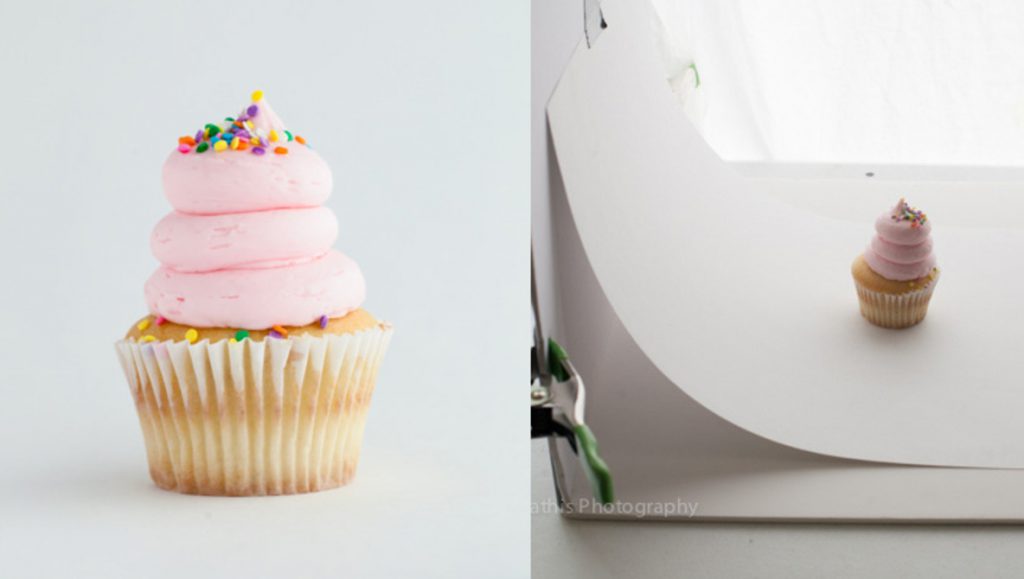
You can check out photographer Taylor Mathis's Fstoppers instance study showing how using a sweep improves the quality of your photos here .
Stride #3: Ready Upwardly Your Product
In one case your lighting and backdrop are in place, it'due south time to place your product. Make certain that you put your production in the front end of your background (before the sweep) and in the center of your surface. You also want to make sure that you've placed it, or your lightbox, on a stable, flat surface.
Pro Tip: When shooting jewelry, you can use a angling line to hang your pieces or glue dots to position rings upright.
Don't forget the small details when placing your products. The tiniest adjustments tin can make or break a photograph. For example, if you lot're shooting a bottle with a label, you want to brand sure that the label is 100% centered to the camera.
Step #4: Set Up Your Tripod
You've got your lights, your backdrop, and your product. Now it's time to fix your tripod. The reason a camera or smartphone tripod is so important is that information technology ensures that y'all're keeping a constant focus and depth. It's much better to motion the product slightly than to move the camera. Tripods as well mean that your photographic camera is stable plenty to use the fastest shutter speeds possible, ensuring your whole production is focused well.
Footstep #5: Make Sure Your Camera Settings Are Right
The adjacent step is to test your photographic camera settings and get them just correct. Y'all will need to tweak this to ensure that you are taking the best photos possible. Here are our superlative camera setting tips:
- Epitome size: Select the biggest image size and file size options your camera or phone has. Ideally, you will want to shoot in RAW if your photographic camera allows for information technology.
- Flash: Make sure your wink is off as you will be using either natural light or studio lighting,as outlined above.
- Lens: For those of y'all using DSLRs, you don't desire to use wide-angle lenses every bit this will distort your products.
- ISO: The college the ISO, the brighter the product prototype will be. However, the higher the ISO number, the more distorted (noisy) your photo will be. If you're using studio lighting, set your ISO to its lowest – 100.
- Quality: Set up your prototype quality to its highest.
- Aperture Setting (A): F8-F11 will requite you the best depth of field for product images. Likewise wide an aperture setting (F2.8 or 4.5) will mean not all of your product will be in focus.
- Shutter speed: The smaller the number, the brighter your photo will be. However, because this setting makes your digital camera sensitive to movement, you'll need a tripod to avoid blurry images.
- White balance: If yous're a beginner, set your white residual to "automatic." For more experienced photographic camera uses using studio lighting, endeavour setting your white residual to "flash".
- Filters: Avert using digital filters or camera light filters as this could distort the true colors of your product.
- Timer: To aid eliminate the take a chance of product image blurriness, use the camera's self-timer.
Step #vi: Taking the All-time eCommerce Product Images
Finally, yous're prepare to have those crawly white background photos! Here are our summit tips when shooting your product photos:
ane. Accept Test Shots
Before you go to boondocks and go snappy-happy, take a test shot (or a few) earlier shooting each new product image. This ensures your camera settings, lighting, and product setup are perfect for easier editing.
It also allows y'all to more than easily make the adjustments you need beforehand, saving yous a lot of editing time.
ii. Don't Delete Images Until You've Seen Them on a Calculator
While you're shooting, don't delete whatever images from your camera until y'all've seen them on your computer screen. A lot of the time, we can judge too speedily on the camera and delete awesome shots. By looking on a bigger screen, later the shoot, you will accept a amend thought of what images have the potential to be edited to greatness and which should be canned.
Pro Tip: Some digital cameras allow you to tether them to a computer, enabling you to see images on your big screen as yous shoot. It's called "shooting tethered." Here's a guide from DIY Photography to become you started: Introduction to Tethered Shooting .
3. Have Enough of Photos from Different Angles
While you're shooting, take as many photos every bit you tin can from dissimilar product angles. Move the product effectually until you've shot every attribute to find its most attractive side.
Plus, having dissimilar perspectives on your website, like kids wearing apparel store Wee Squeak , helps your customers see all sides of the product they want to buy.
four. Highlight Product Details
Your photos should highlight all the qualities of your product. People should be able to get a sense of the texture, pattern, shape, and scale. This could mean putting a coin in to show size or zooming in on certain textures or designs that make your product smoothen.
Call up, your photos are the but matter showing potential shoppers exactly what they are getting.
Pro Tip: Consider adding a product photograph that includes more than than one color choice of your product to help your shopper choose their favorite.
5. Let Those Production Features Shine
Think to prove off your production's almost appealing features. If yous're selling a wallet or a handbag, for case, you want to prove a photograph with information technology closed and of the inside of the production. Both are of import features that people consider when ownership a wallet.
Bonus Tip for Big Products
For those of you wanting to shoot larger products similar tables or people wearing your wearing apparel, it can exist done. However, yous are going to have to invest in larger backdrops and more than substantial studio lighting. In principle, the concepts mentioned here volition be similar, but it may accept a little more fourth dimension and brainpower to understand the tech side of things. Hither's a beginner'southward guide to what'south involved in shooting bigger products.
How to Edit White Background Production Photography Similar a Pro
When editing your photos, you lot desire to brand sure that they are bright (the exposure is good), the colors are bright only still true to your product, that unnecessary spots or dust are removed, that you've cropped (framed) your products well, and that your images are sized correctly for the platform you're posting them to.
Here are steps to getting your production photo editing right.
Step #1: Remove Backdrop Edges
The first thing yous want to focus on is backdrop removal. This means y'all crop the production image so that all the edges that bear witness the stop of your backdrop accept been removed, leaving you with merely the product and white background.
Step #2: Adjust Background Brightness
Once you accept covered the properties removal, you will need to lighten your background so that it is vivid and white instead of dull and gray.
Pace #three: Retouch Those Spots
Now it's time to delete spots. This means erasing any fibers or dust that are showing on your backdrop or products.
Step #iv: Make Color Adjustments
Adjust the brightness, exposure, and saturation of your prototype to make sure the colors pop while ensuring that they still match the real thing every bit much equally possible.
Stride #5: Optional: Consider Adding a Shadow
Once your white background is edited and your products are shining, you can add a shadow to your product if need be.
Step #6: Removing or Editing Background Color
In one case your product image is edited and perfect, you lot could then change the groundwork color if you're using different backgrounds for marketing banners like Mrs Bow Tie does, every bit shown below.
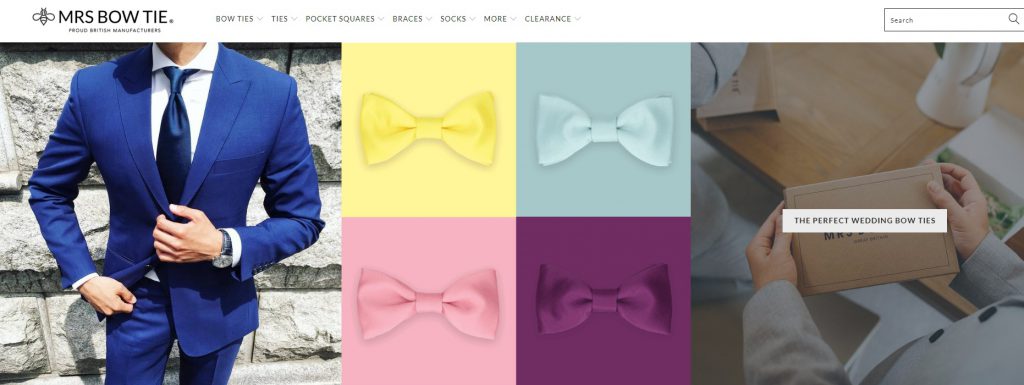
Past shooting on a white backdrop perfectly and then editing your production images professionally, you will make changing to a colored groundwork much easier. Colored backgrounds are keen for social media marketing and landing pages.
Step #seven: Saving and Resizing Images
You want to shoot and edit at the highest quality, and so resize your edited photo to the dimensions you lot demand. Each platform, marketplace, or PPC campaign type has its own guidelines. So when y'all're saving an paradigm, save it within the ratio and size per platform.
For example, on Shopify, the accepted ratio is 1:ane. Save time by saving all the formats at in one case when yous're finished with a product photo.
Pace #eight: Optimizing Your Photos for SEO
The concluding pace is ensuring your images have been optimized for SEO. That means naming them correctly and compressing the final paradigm so that it doesn't impact your page load times. For more on how to optimize your online shop with DIY SEO, bank check out these two guides:
- Grow Organic Traffic in 8 Steps
- Shopify SEO: How to Get Your Shopify Store to Rank #1 on Google
Pro Tip: For those of y'all already familiar with Photoshop, here's a cracking tutorial on editing product photographs on a white backdrop or background from Olivia Hayward .
Wrapping Upwardly: DIY Product Photography on a White Background
At that place you lot have information technology – your full guide to production photography on a white background.
Every bit your store grows and the number of products y'all offer increases, product photography tin brainstorm to experience like a full-time job.
In this case, nosotros would propose hiring exterior freelancers or service providers to aid you get new products online ASAP and scale up your product listings for Google Shopping and other eCommerce ads . Don't forget your hero image – with master store CTAs – for your dwelling page. [Bank check out these eCommerce call-to-action examples for inspiration]
If you lot have product photography questions, experience free to post them in the comments below.
Happy shooting!
Pro eCommerce PPC and Social Media Marketing Tip: It's fourth dimension to automate your TikTok Ads, Facebook ads, Google Ads campaigns, and remarketing ads from one place! Traffic Booster is the but eCommerce-focused total PPC management software that will create, manage, and optimize your campaigns in existent-time for peak performance. It is far more than just an culling to WordStream , offering machine-learning campaign optimization and marketing practiced help. You tin find out more about choosing the right plan to adjust your budget and business needs here .


Nicole Blanckenberg
Nicole is a content writer at StoreYa with over sixteen years feel and flair for storytelling. She runs on a healthy dose of caffeine and enthusiasm. When she's not researching the adjacent content trend or creating informative small business content, she's an gorging beachgoer, coffee store junkie and hangs out on LinkedIn.
Comments
Powered by Facebook Comments
How To Edit White Product On White Background,
Source: https://blog.storeya.com/2018/10/product-photography-white-background/
Posted by: scottaskins90.blogspot.com

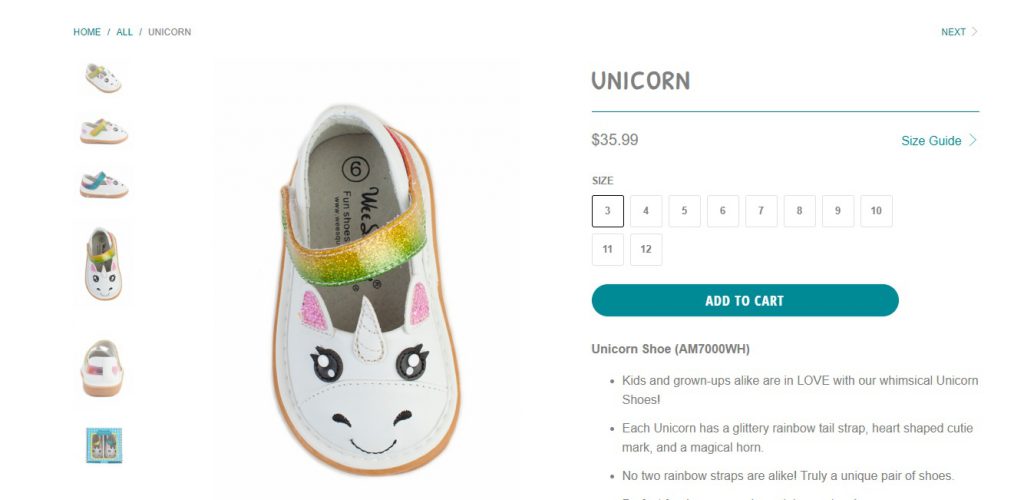

0 Response to "How To Edit White Product On White Background"
Post a Comment